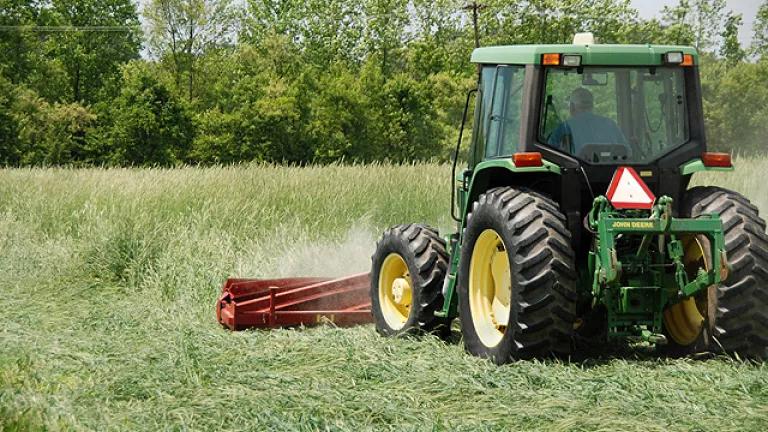USDA Announces Second Year of Insurance Savings Program
This announcement is a banner moment for regenerating soil health on our nation's farms, protecting the economic vitality of rural America, and helping American agriculture confront the growing climate crisis.

Cover crops are used to improve soil health. This farmer is using a roller crimper to mow down the cover crop so it can add organic matter and protect the soil.
Steve Mirsky, USDA-ARS
USDA announced a second year of the Pandemic Cover Crop Program, which offers farmers who plant cover crops savings on their crop insurance bills. Cover crops are an important practice for building healthy soil, improving water quality, and even help mitigate and fight climate change. Healthy soil is also a way for farmers to prepare for the impacts of climate change, as it retains more moisture in times of drought or flood. The program is like getting a good driver discount on your auto insurance – a good stewardship discount for farmers.
This announcement came on the wings of another from USDA, a historic investment of $1 billion in a new program, the Partnership for Climate Smart Commodities. In January, USDA also launched the Farmers for Soil Health Initiative, with a goal of increasing cover crops on corn and soybean acres to 30 million acres by 2030. These announcements are a welcome signal of the Biden Administration’s intent to make good on promises to promote climate-friendly agriculture. The crop insurance incentive program will be welcome news for cover croppers, who enrolled more than 12 million acres in the first year of the program, according to USDA. Many farmers depend on crop insurance as a safety net or are even required by the bank or their landlord to have crop insurance, so the program works well as an incentive because it’s integrated with a program many already use.
A number of lawmakers deserve credit for sounding the drumbeat in advance of this announcement, too; as the House Agriculture Committee began a series of hearings in January to prepare for reauthorization of the Farm Bill, which expires in 2023. The Pandemic Cover Crop Program was a topic of interest for several members of Congress at these recent hearings. On January 20th, Congresswoman Axne asked Secretary Vilsack about the program in a hearing about the rural economy. Congressman Panetta asked Secretary Vilsack about agency cooperation to implement the program in the February 2nd hearing for the Subcommittee on Conservation. In a February 8th hearing for Undersecretary Robert Bonnie, Congresswoman Bustos asked how many acres were enrolled in the program and if the program would be offered for a second year. These hearings and the USDA announcement set the stage for a redraft of the Farm Bill, showing broad interest from Congress and USDA in the transformational and restorative impacts of cover crops.
The Pandemic Cover Crop Program is modeled on state-based programs in Iowa, Illinois, and Indiana. NRDC strongly supports the state and federal programs and we worked side-by-side with other NGOs, USDA, and state government to champion their success. For future program success, it will be necessary to offer the program on a long-term basis, creating certainty for farmers that they can factor into their decisions when deciding whether they can afford to buy cover crop seed. For the next Farm Bill, Congress should expand on this important progress, and authorize a long-term, nationwide savings program for farmers who use cover crops and build soil health. The time is ripe.




